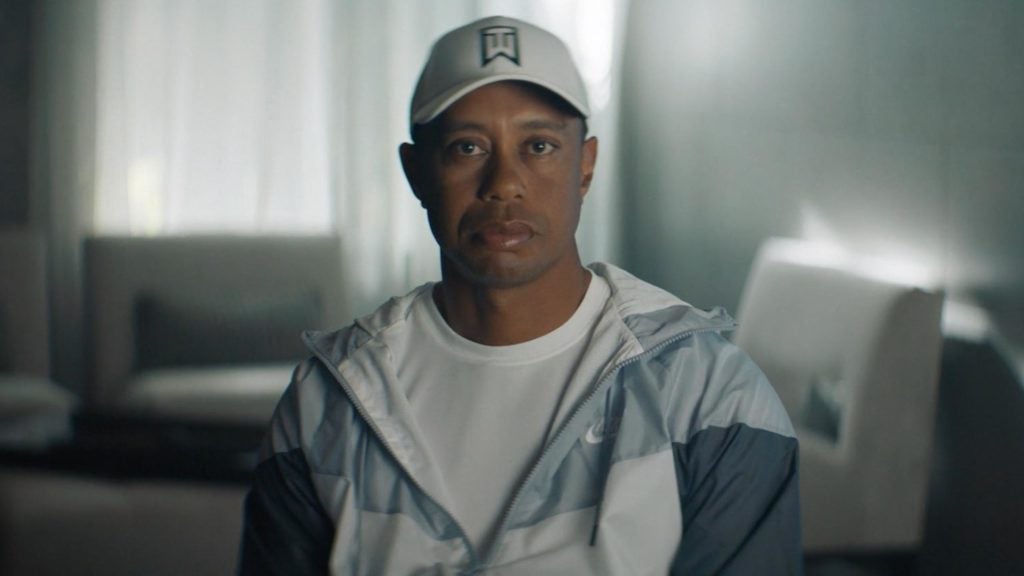It’s either wrong or just strange to say so, but Tiger Woods’ most revealing recent interview just came via commercial.
Maybe commercial isn’t quite right. I don’t know the exact terms of the deal between Woods and Centinel Spine. But what I do know is the latter just released a seven-minute, professionally-produced testimonial featuring the 15-time major champion in a particularly vulnerable light, talking through the spinal surgery that changed his life.
So let’s talk about what Woods says in the video that resonates. First there he is, walking by a pool with a backwards “TW” hat on, a decidedly Floridian scene. (For whatever it’s worth, the scenes and scenery suggest that this was actually filmed at the Floridian, an upscale golf club in Palm City. It’s hard to get more Florida than the Floridian.)
“A day in the life would be very easy: I wouldn’t move,” he says. He remembers that seconds would pass like days. “It was only a few months in which I really hit my low point. That seemed to me like 30 years,” he says.
It’s amazing, imagining this scene, a premier world athlete lying helpless and motionless at home. It’s a jarring, moving mental picture, even shot in 4k in a branded video. Reporters have asked Woods for years and he’s offered rote details of his time injured, but more often he’s delivered reporters some version of just how optimistic he’s feeling. Brooks Koepka’s short game coach Pete Cowen described it the other day: “[Tiger] would tell everyone that he might not be playing well but he was getting there,” he said.
Well, not this time. Tiger remembers his kids, Sam and Charlie, bringing their Legos close to his chair so that he’d feel included, like he was playing alongside them. The most vicious conquerer in modern golf history was laid so low his own children were trying to make sure he felt included.
One line sticks out, a line about the refrigerator. “It was hard to try and wrap my head around it. Can I get up to the refrigerator or am I not really that thirsty?” Imagine making that calculation for something beyond laziness. “That’s just how life was,” Woods says.
The scene in the chair is striking, too. Woods’ kids would go to bed, he’d be in his chair. Wake up, he’d be in his chair. Go to school, come home, he’d be in his chair.
“I just didn’t move,” he says. “It was off the charts, very hard to deal with physically, emotionally, spiritually. It tested me more so than any other time in my life.”
Again, I know that this is hardly admissible testimony; it’s an infomercial. But it’s almost like the guise of Woods’ assignment — it’s your job to sell us on the before and after of this surgery — gave Woods permission to be something he’s unused to: open and honest.
It’s clear that Woods had basically exhausted all other options by the time he hit on back fusion surgery. The licensed clips from Tour events that Centinel got of Woods wincing, falling to his knees, withdrawing from tournaments? Those drove that particular point home. As did this association: “The word fusion means you’re done.”
It was clear that Woods didn’t sign up for this particular surgery so that he could come back and contend in major championships; he signed up for this so that the pain would go away and he might live some semblance of a normal life.
It’s remarkable how quickly the surgery seemed to work on Woods. That he was able to stand up, pain-free, right after the surgery. That attitude: “Who cares? My leg works.”
The story has a more complex ending, of course, than Centinel Spine might have you believe. Post-surgery life did not start and stop with a Masters victory. There were battles before that, and Woods is hardly 100 percent healthy now — his new yearly schedule likely amounts to 10 or so events, with questionable health and comfort at each stop.
Still, he’s vertical. He’s upright. He’s moving around. He even has the potential to play some serious golf, when the stars align. That, as he says, is all just icing on the cake.
A final aside: That magazine he’s holding? That’s a Sports Illustrated cover story from 2016 by our own Alan Shipnuck that Woods is reading so intently.
It’s an article (which you can read here) wondering what exactly happened to this generation’s greatest golfer. That may not be an explicit endorsement of the article. But it’s an acknowledgement of where he was then, and where he is now, and all the important space in between. That’s worth something, to be sure.
You can watch the video below.
